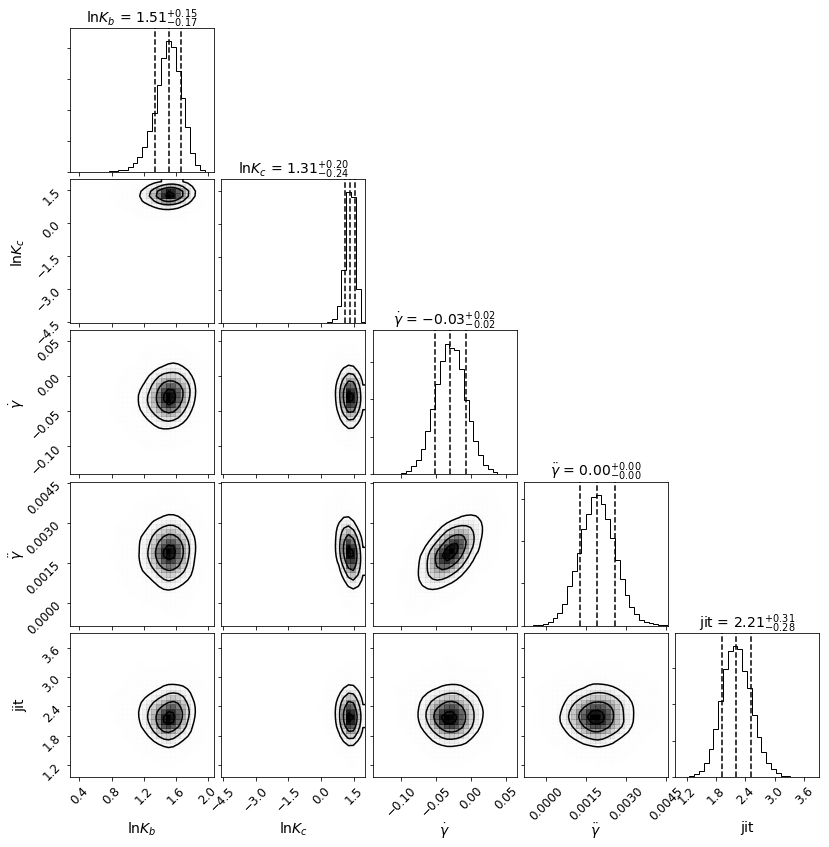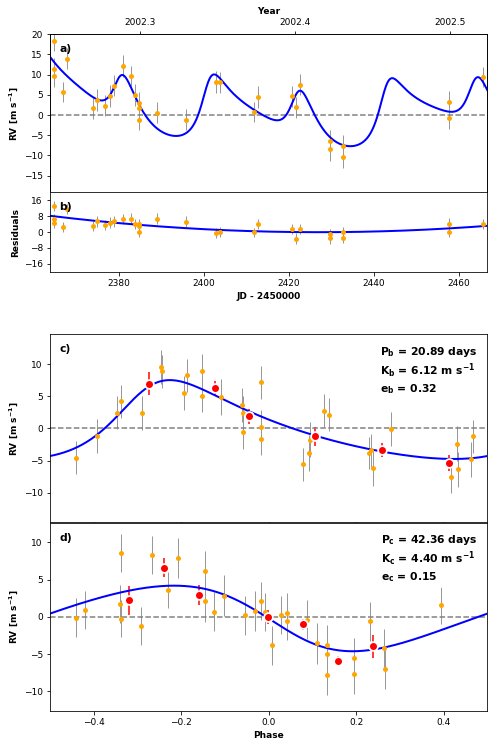K2-24 Fitting & MCMC¶
Using the K2-24 (EPIC-203771098) dataset, we demonstrate how to use the radvel API to:
- perform a max-likelihood fit
- do an MCMC exploration of the posterior space
- plot the results
Circular Orbits¶
Perform some preliminary imports:
[ ]:
%matplotlib inline
import os
import matplotlib
import numpy as np
import pylab as pl
import pandas as pd
from scipy import optimize
import corner
import radvel
import radvel.likelihood
from radvel.plot import orbit_plots, mcmc_plots
matplotlib.rcParams['font.size'] = 14
Define a function that we will use to initialize the radvel.Parameters and radvel.RVModel objects
[2]:
def initialize_model():
time_base = 2420
params = radvel.Parameters(2,basis='per tc secosw sesinw logk') # number of planets = 2
params['per1'] = radvel.Parameter(value=20.885258)
params['tc1'] = radvel.Parameter(value=2072.79438)
params['secosw1'] = radvel.Parameter(value=0.01)
params['sesinw1'] = radvel.Parameter(value=0.01)
params['logk1'] = radvel.Parameter(value=1.1)
params['per2'] = radvel.Parameter(value=42.363011)
params['tc2'] = radvel.Parameter(value=2082.62516)
params['secosw2'] = radvel.Parameter(value=0.01)
params['sesinw2'] = radvel.Parameter(value=0.01)
params['logk2'] = radvel.Parameter(value=1.1)
mod = radvel.RVModel(params, time_base=time_base)
mod.params['dvdt'] = radvel.Parameter(value=-0.02)
mod.params['curv'] = radvel.Parameter(value=0.01)
return mod
Define a simple plotting function to display the data, model, and residuals
[3]:
def plot_results(like):
fig = pl.figure(figsize=(12,4))
fig = pl.gcf()
fig.set_tight_layout(True)
pl.errorbar(
like.x, like.model(t)+like.residuals(),
yerr=like.yerr, fmt='o'
)
pl.plot(ti, like.model(ti))
pl.xlabel('Time')
pl.ylabel('RV')
pl.draw()
Load up the K2-24 data. In this example the RV data and parameter starting guesses are stored in an csv file
[4]:
path = os.path.join(radvel.DATADIR,'epic203771098.csv')
rv = pd.read_csv(path)
t = np.array(rv.t)
vel = np.array(rv.vel)
errvel = rv.errvel
ti = np.linspace(rv.t.iloc[0]-5,rv.t.iloc[-1]+5,100)
Fit the K2-24 RV data assuming:
- circular orbits
- fixed period, time of transit
Set initial guesses for the parameters. Setting vary=False and linear=True on the gamma parameters will cause them to be solved for analytically following the technique described here (Thanks Tim Brandt!). If you use this you will need to calculate the uncertainties on gammas manually following that derivation.
[5]:
mod = initialize_model()
like = radvel.likelihood.RVLikelihood(mod, t, vel, errvel)
like.params['gamma'] = radvel.Parameter(value=0.1, vary=False, linear=True)
like.params['jit'] = radvel.Parameter(value=1.0)
Choose which parameters to vary or fix. By default, all radvel.Parameter objects will vary, so you only have to worry about setting the ones you want to hold fixed.
[6]:
like.params['secosw1'].vary = False
like.params['sesinw1'].vary = False
like.params['secosw2'].vary = False
like.params['sesinw2'].vary = False
like.params['per1'].vary = False
like.params['per2'].vary = False
like.params['tc1'].vary = False
like.params['tc2'].vary = False
print(like)
parameter value vary
per1 20.8853 False
tc1 2072.79 False
secosw1 0.01 False
sesinw1 0.01 False
logk1 1.1 True
per2 42.363 False
tc2 2082.63 False
secosw2 0.01 False
sesinw2 0.01 False
logk2 1.1 True
dvdt -0.02 True
curv 0.01 True
gamma 0.1 False
jit 1 True
Plot the initial model
[7]:
pl.figure()
plot_results(like)
<Figure size 432x288 with 0 Axes>

Well that solution doesn’t look very good. Now lets try to optimize the parameters set to vary by maximizing the likelihood.
Initialize a radvel.Posterior object and add some priors
[8]:
post = radvel.posterior.Posterior(like)
post.priors += [radvel.prior.Gaussian( 'jit', np.log(3), 0.5)]
post.priors += [radvel.prior.Gaussian( 'logk2', np.log(5), 10)]
post.priors += [radvel.prior.Gaussian( 'logk1', np.log(5), 10)]
post.priors += [radvel.prior.Gaussian( 'gamma', 0, 10)]
Maximize the likelihood and print the updated posterior object
[9]:
res = optimize.minimize(
post.neglogprob_array, # objective function is negative log likelihood
post.get_vary_params(), # initial variable parameters
method='Nelder-Mead', # Powell also works
)
plot_results(like) # plot best fit model
print(post)
parameter value vary
per1 20.8853 False
tc1 2072.79 False
secosw1 0.01 False
sesinw1 0.01 False
logk1 1.55037 True
per2 42.363 False
tc2 2082.63 False
secosw2 0.01 False
sesinw2 0.01 False
logk2 1.37648 True
dvdt -0.0292189 True
curv 0.00182259 True
gamma -3.99195 False
jit 2.09753 True
Priors
------
Gaussian prior on jit, mu=1.0986122886681098, sigma=0.5
Gaussian prior on logk2, mu=1.6094379124341003, sigma=10
Gaussian prior on logk1, mu=1.6094379124341003, sigma=10
Gaussian prior on gamma, mu=0, sigma=10

That looks much better!
Now lets use Markov-Chain Monte Carlo (MCMC) to estimate the parameter uncertainties. In this example we will run 400 steps for the sake of speed but in practice you should let it run at least 10000 steps and ~50 walkers. If the chains converge before they reach the maximum number of allowed steps it will automatically stop.
[10]:
df = radvel.mcmc(post,nwalkers=20,nrun=400,savename='rawchains.h5')
8000/64000 (12.5%) steps complete; Running 12210.22 steps/s; Mean acceptance rate = 57.3%; Min Auto Factor = 22; Max Auto Relative-Change = inf; Min Tz = 1176.3; Max G-R = 1.024
Discarding burn-in now that the chains are marginally well-mixed
64000/64000 (100.0%) steps complete; Running 13032.47 steps/s; Mean acceptance rate = 55.1%; Min Auto Factor = 50; Max Auto Relative-Change = 0.169; Min Tz = 4270.9; Max G-R = 1.007
MCMC: WARNING: chains did not pass convergence tests. They are likely not well-mixed.
Now lets make a corner plot to display the posterior distributions.
[11]:
Corner = mcmc_plots.CornerPlot(post, df)
Corner.plot()

Eccentric Orbits¶
Allow secosw and sesinw parameters to vary
[12]:
like.params['secosw1'].vary = True
like.params['sesinw1'].vary = True
like.params['secosw2'].vary = True
like.params['sesinw2'].vary = True
Add an EccentricityPrior to ensure that eccentricity stays below 1.0. In this example we will also add a Gaussian prior on the jitter (jit) parameter with a center at 2.0 m/s and a width of 0.1 m/s.
[13]:
post = radvel.posterior.Posterior(like)
post.priors += [radvel.prior.EccentricityPrior( 2 )]
post.priors += [radvel.prior.Gaussian( 'jit', np.log(2), np.log(0.1))]
Optimize the parameters by maximizing the likelihood and plot the result
[14]:
res = optimize.minimize(
post.neglogprob_array,
post.get_vary_params(),
method='Powell',)
plot_results(like)
print(post)
parameter value vary
per1 20.8853 False
tc1 2072.79 False
secosw1 0.398041 True
sesinw1 -0.404209 True
logk1 1.8115 True
per2 42.363 False
tc2 2082.63 False
secosw2 -0.124394 True
sesinw2 0.37035 True
logk2 1.48072 True
dvdt -0.0297857 True
curv 0.00206207 True
gamma -4.52471 False
jit 1.9542 True
Priors
------
e1 constrained to be < 0.99
e2 constrained to be < 0.99
Gaussian prior on jit, mu=0.6931471805599453, sigma=-2.3025850929940455

Plot the final solution
[15]:
RVPlot = orbit_plots.MultipanelPlot(post, legend=False)
RVPlot.plot_multipanel()
[15]:
(<Figure size 540x786.857 with 5 Axes>,
[<matplotlib.axes._subplots.AxesSubplot at 0x7fc70affe908>,
<matplotlib.axes._subplots.AxesSubplot at 0x7fc6d8861f28>,
<matplotlib.axes._subplots.AxesSubplot at 0x7fc72a3f1f28>,
<matplotlib.axes._subplots.AxesSubplot at 0x7fc70b03ea58>])
